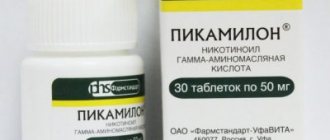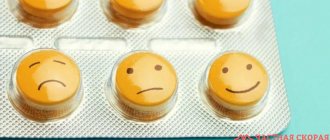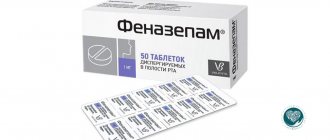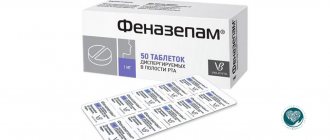Pharmaceutical action
Sleeping pills lull, calm, and relax muscles. It is especially often prescribed for insomnia. It should be noted that it has a rather harsh effect on the nervous system - it slows down the transmission of signals between nerve cells. Signal transmission controls all processes occurring in the body.
Therefore, taking phenazepam is not only a switch between “activity-rest” or “wakefulness-sleep”. This is also, for example, suppression of breathing...
In addition to its sedative and hypnotic effects, the medicine has the property of depressing breathing. Sometimes you have to pay for the strong effect with attacks of suffocation in your sleep. Be careful not to take the sleeping pill phenazepam without a doctor's prescription! It is sold in pharmacies by prescription.
Can phenazepam be used as a sleeping pill for any type of insomnia? In no case. Only in difficult situations, when sleep disturbances are caused by neuroses, high nervous excitability, and severe stress.
Mental disorders affect hundreds of millions of people around the world, but the resources available in most countries to treat these diseases, according to the World Health Organization (WHO), are insufficient [1]. Levels of consumption of psychotropic substances, in particular benzodiazepine tranquilizers (hereinafter referred to as BDTs), used to treat conditions such as anxiety, insomnia and epilepsy, vary significantly across countries and regions [1]. As is known, the advantages of benzodiazepine derivatives include the rapid onset of response to therapy, a wide range of activity, including anti-anxiety, hypnotic, vegetostabilizing, muscle relaxant and anticonvulsant effects, ease of prescription and administration of these drugs [2-5]. Insufficient or inappropriate access to psychotropic substances is particularly pronounced in low- and middle-income countries, where it is estimated that only one in five people who need treatment receive the necessary treatment. According to the International Narcotics Control Board, the most important factors affecting the provision of psychotropic drugs to patients are the specifics of the regulatory framework, lack of knowledge among medical personnel, the economic situation and supply problems in the country [1]. In 2015, the most common reasons cited by countries with limited use of RDTs were concerns about the potential for addiction, reluctance to prescribe and/or stock the drugs, and insufficient training of health professionals [1].
The question of the possibility of drug dependence on RDT has long remained controversial [5]. In studies devoted to the study of the frequency of dependence formation as a result of long-term use of BDT, there was a significant scatter and heterogeneity of data: according to different researchers, it ranged from tenths to 100% [6, 7]. Signs of addiction are a decrease in the effectiveness of RDT with increasing dosage of the drug; development of tolerance to the effects of RDT, first to the sedative, then to the muscle relaxant, then to the anxiolytic; presence of withdrawal syndrome [2, 3]. A separate group includes the so-called “small dose dependence” - a condition that occurs as a result of long-term use of sub- and therapeutic doses of BDT according to indications. At the same time, patients are determined to have a desire not for a specific substance, but for a class of drugs, the absence of an increase in RDT doses, the facultative nature of the withdrawal syndrome, and the absence of pronounced consequences from the use of drugs [7].
According to the mechanism of formation of dependence on RDT, there are two main options [2, 3]:
- first - RDTs are taken in connection with mental disorders, with or without a doctor’s prescription, for a period of more than a month. Researchers emphasize that this variant of the formation of dependence is most typical for patients of a “psychopathic disposition”, persons with a certain hypochondriacal attitude with a desire for treatment, for patients with dependent personality traits;
- second option - RDTs are taken by patients as self-medication for psychoactive substance withdrawal syndrome (PAS) or to enhance the effect of PAS. The highest prevalence of RDT abuse in the world is currently reported among clients of opioid substitution therapy programs. Thus, 45% of patients undergoing methadone treatment in France and up to 70% in Germany abuse BDT. Data on trends in the abuse of BDT among users of psychoactive substances indicate relative stability in the indicators in the period 2006–2013, with a decrease in 2014 [8, 9].
According to the latest epidemiological data, the number of patients who abuse non-narcotic psychoactive substances (substance abuse patients), including dependence on RDT, in the Russian Federation is small and is steadily declining [10, 11]. Thus, the number of substance abusers registered by the drug treatment service in 2021 amounted to 8615 people - this is 0.0073% of the total adult population (including ~118,000,000 population 18 years of age and older, 2015) (without division by drug , since in the Russian Federation cases are not registered for each individual non-narcotic surfactant or drug) (in 2015, 9796 cases were observed). For comparison, data from official drug addiction statistics in the Russian Federation (2015) indicate that approximately 2% (more than 2.1 million) had alcohol dependence with harmful consumption of alcohol, which is somewhat at odds with the calculations of WHO experts, who speak of 9% ( in 16.5% of men and 3.3% of women over 14 years of age), therefore solving the alcohol problem is a priority at the state level. Also, the overall incidence of substance abuse in the Russian Federation in 2021 decreased by 12% compared to the level of 2015 and amounted to 5.9 per 100 thousand population (in 2015 - 6.7, in 2012 - 8.1 ). The level of referrals for harmful use decreased by almost 19% compared to 2015 (11.5). The total turnover rate of persons using non-narcotic psychoactive substances in 2021 was 15.3 per 100 thousand population. For the first time in their lives, 497 substance abuse patients sought drug treatment help in 2021 (608 in 2015). The primary incidence rate of substance abuse in 2015 was 0.3 per 100 thousand population (0.4 in 2015) [10, 11]. The most commonly abused drugs are diazepam, lorazepam, nitrazepam, phenazepam, alprazolam, clonazepam, and less commonly, elenium [12-15]. To minimize the risk of developing dependence on RDT, it has been proposed:
1. Correctly assess the duration of the course (avoiding long-term treatment of insomnia, but taking into account that anxiety disorders require long-term therapy).
2. Select the dosage so that the therapeutic effect is maximum and side effects are minimal.
3. Limit the use of RDT in persons with a history of substance dependence syndrome.
4. Use “cover” therapy - prescribe anxiolytics with a different mechanism of action or RDT with a longer half-life (for example, phenazepam).
5. Involve active psychotherapy, gradually discontinue medications, identify patients with an exaggerated attitude towards treatment and a tendency to self-medicate, and control the possibility of RDT abuse [2, 13, 15].
The purpose of this review is to analyze literature data on the role and place of phenazepam in the formation of RDT dependence syndrome.
Phenazepam (bromodihydrochlorophenylbenzodiazepine) is a domestically produced BDT drug. The main “target” of phenazepam’s action is anxiety, which occurs as part of various pathologies: neurosis, depression, generalized anxiety disorder, post-traumatic stress disorder, panic disorder, social phobia, obsessive-compulsive disorder, psychosis [2, 12-14, 16]. Along with the anxiolytic drug, it has a moderate antidepressant effect and is effective in the treatment of obsessive-phobic and hypochondriacal symptoms, affective-delusional, oneiric and other psychotic conditions, including by reducing the severity and severity of their affective component. Phenazepam has an effect on the central nervous system, mainly in the structures of the limbic system, thalamus and hypothalamus by increasing the activity of γ-aminobutyric acid (GABA), an inhibitory neurotransmitter. The drug modulates the activity of GABA receptors by binding it to the benzodiazepine regulatory site of the GABA receptor (“benzodiazepine receptor”), this leads to increased binding of GABA to the receptor and, as a result, the opening of a channel associated with the receptor for chlorine ions, to depolarization of the nervous system. cells and ultimately reducing its excitability [3, 4]. All RDTs enhance the specific binding of agonists to GABA receptors, simulate the reception of chloride ion channel ligands, and increase the frequency of ionophore openings, which leads to hyperpolarization of neuronal membranes and an increase in the seizure threshold [17].
The drug is well absorbed from the gastrointestinal tract, the maximum concentration in the blood is reached 1-2 hours after oral administration, the half-life is 6-10 hours, excretion occurs mainly through the kidneys [3, 4]. Phenazepam has the largest range of effective therapeutic doses among BDTs, from 0.25 to 10 mg. In terms of anxiolytic effect, phenazepam is 2 times superior to diazepam and 5 times superior to clonazepam and nitrazepam, comparable to lorazepam, however, it has a longer effect, which is its absolute advantage in maintenance therapy; in addition, the drug is ahead of them in hypno-sedative, anticonvulsant , as well as vegetative stabilizing effects [2, 12-15].
A meta-analysis of more than a dozen clinical studies has shown the significant effectiveness of phenazepam both in comparison with placebo and with a number of other RDTs in relation to anxiety disorders, irritability, sleep disorders, and somatovegetative disorders; with its use, improvement was observed in more than half of the patients included in the studies. Positive results were also obtained when using phenazepam in combination therapy with anticonvulsants for the treatment of various types of seizures in epilepsy. Thus, the introduction of phenazepam into the treatment regimen for resistant polymorphic attacks led to a complete cessation or a halving of their frequency in 60% of patients [12-15]. The drug is successfully used in the treatment of somatogenic and psychosomatic disorders: it is effective in anxiety, anxiety-phobic and accompanying autonomic disorders in cardiovascular, gastrointestinal, pulmonary, gynecological and other somatic pathologies [18]. In psychiatry, phenazepam is often used in combination therapy, for example, with antidepressants and antipsychotics. One of the options that meets the clinical needs of therapy is the use of phenazepam in combination with antidepressants in the treatment of anxiety and depressive disorders at the stage of initiation of treatment, in the first 3-4 weeks (until the anti-anxiety and antidepressant effects of the antidepressant are fully manifested). In this case, the main, gradually increasing effect is exerted by the antidepressant, and phenazepam is used to relieve anxiety and sleep disorders (since anxiety symptoms may intensify in the first weeks), thereby providing “cover therapy” and better tolerability and adherence to antidepressant therapy. The presence of a muscle relaxant effect in phenazepam makes it effective for use in neurological disorders such as extrapyramidal disorders, increased muscle tone and pain (conditions associated with tardive dyskinesias, essential tremor, restless legs syndrome, dorsalgia) [18].
Phenazepam is actively used in drug treatment practice due to its ability to eliminate anxiety, agitation, insomnia, influence vegetative symptoms and prevent the development of convulsive seizures; it is the drug of choice for the treatment of alcohol withdrawal syndrome. Adequate RDT therapy can also prevent the development of alcoholic delirium. In case of withdrawal syndrome occurring with delirium, RDTs are used as sedatives [2]. In addition, phenazepam is effective in the treatment of drug addiction, with the development of conditions accompanied by anxiety, obsessive-phobic disorders, aggravation and affective tension [19]. The dosage of BDT is adjusted in accordance with the clinical characteristics of the patient's condition.
The recommendations in the literature [3, 4, 20] on the use of RDTs take into account the issues of their tolerability, adverse events, dosage regimen and criteria for the duration of courses of therapy. It is noted that if the general recommendations include courses of therapy not exceeding 1-2 months, then a longer prescription of RDT is required in the treatment of panic disorder and generalized anxiety disorder, which have a chronic course. In addition, long-term use of BDT, including phenazepam, is allowed for elderly patients, in whom low and constant doses completely reduce symptoms, and for patients with chronic neurological and somatic diseases (prescription of doses adequate to the condition is safe), as well as for patients in whom use in variable and fractional doses leads not only to a reduction in symptoms, but also to an improvement in daily functioning and “quality of life” [2]. In any case, at the beginning of RDT therapy, it is recommended to prescribe the drug in lower doses, which allows assessing the patient's sensitivity to the drug and avoiding excessive sedation. Doses of the drug are increased gradually, monitoring possible side effects until a therapeutic effect appears.
Of interest are the studies conducted by A.S. Avedisova et al. [6, 7], devoted to the peculiarities of treatment of RDT by doctors of outpatient medical institutions in Moscow. It was found that the proportion of use of BDT in comparison with other drugs is quite high - from 52.2 to 76.6% of prescriptions. These drugs are used to correct insomnia, anxiety and behavioral disorders. Among prescriptions, preference (more than 75% of all prescriptions) is given to drugs with medium and high tranquilizing potential: phenazepam, diazepam, clonazepam, alprazolam, and they are prescribed predominantly (90% of all prescriptions) in subtherapeutic and therapeutic doses as part of combination therapy and with no trends to increase dosages. Courses of taking BDT lasting more than 12 months were very rare (less than 5% of all patients in psychoneurological dispensaries) [6, 7]. A number of researchers [21, 22], however, report that the number of patients receiving RDT for 2 or more months is almost 60%, and for more than 12 months - up to 25%. Long-term administration of RDT was generally required in accordance with the above recommendations for the treatment of panic disorder and generalized anxiety disorder.
A significant part of the existing work is devoted to dependence on RDT. Addiction is defined as a set of cognitive, affective, behavioral and physiological signs that indicate an irresistible craving for a drug and an inability to control its consumption, despite the negative medical and social consequences that arise. Most often, addiction is caused by highly potent drugs with a short-term effect (midazolam, triazolam, lorazepam). However, the risk of developing dependence is greatly exaggerated and in most cases, if RDT is used correctly, it does not occur.
Pharmacological dependence is often confused with drug addiction, which increases the likelihood of disagreement about the development of dependence and, accordingly, the use of RDT among both doctors and patients. As an example of addiction, we can consider some antihypertensive, antiarrhythmic or anti-ischemic drugs (clonidine, β-blockers - propranolol, metoprolol, etc.), ACE inhibitors, which also cause pharmacological dependence, or rather addiction: after stopping their use or replacing them with other drugs, renewal (sometimes more pronounced compared to the initial level) of symptoms of hypertension, ischemia or arrhythmia (rebound syndrome), but patients do not develop addictive behavior [2]. These possible negative manifestations do not frighten internists, and they teach their patients to easily cope with this; to correct such cases, they recommend, first of all, a gradual (non-forced) regime of withdrawal/replacement of pharmacotherapy.
As for RDTs, a targeted program of their withdrawal/replacement and psychotherapeutic correction of the resulting disorders help to avoid independent resumption of drug intake [2, 21]. Long-term use of RDTs can contribute to the formation of pharmacological dependence, characterized by the development of rebound withdrawal syndrome and other conditions caused by discontinuation of the drug [2, 21]. Thus, rebound syndrome is diagnosed upon withdrawal of RDT (including phenazepam) in approximately 50% of cases, withdrawal reaction - in 20%, relapse of the disease - in 15%, withdrawal syndrome - in 5% of cases. Diagnosis of disorders that arise upon discontinuation of BDT use should include an assessment of the symptoms that have arisen and its characteristics (analysis of data from specific scales and questionnaires: anxiety-depressive, withdrawal symptoms and signs of dependence), its relationship with the doses and duration of BDT use, analysis of the time of occurrence and duration of disorders [21]. Rebound syndrome develops in the first days after an abrupt cessation of taking high doses of phenazepam and is manifested by a rapid exacerbation of the condition, most often similar to that before the start of therapy and often exceeding it in severity, followed by a rapid spontaneous reduction of these symptoms within a week. In these cases, patients typically score low on the Addiction Scale and high on the Withdrawal Symptom Questionnaire. When rebound syndrome occurs, it is necessary to constantly monitor the patient and in the event of a rapid resumption and increase in symptoms, RDT therapy should be resumed, and then, after the withdrawal symptoms have been reduced, their dose should be reduced more gradually and smoothly. The use of tactics of gradual withdrawal of RDT over 1-2 months helps to reduce the incidence of rebound syndrome by almost 2 times. It is important to maintain a reasonable rate of reduction in the dose of the drug: approximately 25% per ¼ of the withdrawal period, for example, if the withdrawal period is 4 weeks, then the dose reduction should be carried out at a rate of 25% per week.
Relapse is manifested by the gradual appearance and intensification within a month of symptoms of the underlying disease for which BDT (phenazepam) was prescribed. Pathogenetically, it, being associated with the dynamics of the underlying disease, does not depend on the dosage level and duration of BDT therapy; patients have low scores on both the dependence scale and the withdrawal symptoms questionnaire. Resumption of RDT therapy is a common strategy when relapses occur.
Withdrawal syndrome, in contrast to relapse of the disease and rebound syndrome, includes symptoms that the patient did not have before (tremor, sweating, loss of appetite, nausea, diarrhea, delirium, etc.). Patients score high on both the addiction scale and the withdrawal symptoms questionnaire. Withdrawal syndrome occurs and intensifies within a few days after stopping the drug and gradually disappears after 1-3 weeks. To reduce the risk of developing withdrawal and addiction syndrome, it is whenever possible better to use low-potency drugs with a long half-life, which include phenazepam [2, 21].
Contrary to popular belief, if RDTs are used according to indications, cases of their abuse are quite rare [2]. Patients who use RDT as self-medication for withdrawal symptoms of other psychoactive substances or to enhance the effect of the latter are significantly more likely to be followed up by a narcologist. In such cases, the most typical types of abuse of BDT are the addition of BDT to alcohol or drugs, the use of large doses of BDT in its pure form, vicarious abuse during the absence of the main surfactant. The motive for the combined use of BDT and another surfactant is the desire to achieve more pronounced intoxication. The motivation for using large doses of BDT in its pure form is the desire to “get a buzz” and “get away from troubles.”
Intoxication is achieved by a single dose of doses that are several times higher than therapeutic doses. RDT intoxication is characterized by increased mood, restlessness, and a desire to go somewhere or do something. Outwardly, such patients resemble people who are in a state of severe alcoholic intoxication: movements are imprecise, sweeping, coordination is impaired, the gait becomes uncertain, with staggering. Somatoneurological signs of benzodiazepine intoxication include mydriasis with a sluggish reaction to light, nystagmus, accommodation and convergence disorders, pallor of the skin, dry mucous membranes, tachycardia, hypotension, rapid and shallow breathing, and a decrease in muscle tone is also noted. In patients who abuse large doses of BDT for a long time, a unique personality defect is formed, reminiscent of an organic one [3, 4]. When dependence on RDTs develops, the manifestations of euphoria when taken orally are significantly weakened, which pushes patients to increase the dose of the drug and can lead to an overdose [3, 4, 23, 24]. In some cases, RDT overdoses can be caused by inaccurate explanation to the patient of the drug regimen, which leads to an independent increase in dosage, the occurrence of side effects and discrediting the drug. RDTs, of course, are not the only drugs that require competent and accurate prescription. It should be noted that dangerous cases of increased tolerance, dependence, overdose, rebound or withdrawal syndrome, as well as serious and life-threatening adverse reactions can result from the uncontrolled use of barbiturates, which are prohibited in most countries of the world and have not been included in clinical practice for many years. recommendations for therapy, however, unfortunately, this group of drugs remains in the arsenal of doctors and patients. This fact is confirmed, for example, by the data of K.V. Muzurova et al. (2016): over the past 15 years, in the intensive care unit of the clinic of the Military Medical Academy named after. CM. Kirov received 11,818 patients (on average, approximately 788 cases per year) with acute chemical poisoning; cases of poisoning with sleeping pills and sedatives amounted to 11.8%, among which poisoning with phenobarbital as part of the drug Corvalol accounted for 3.0% [25].
From the above it follows that there is no reason, following prejudices, to refuse to use RDT. However, their prescription requires a careful diagnostic assessment of the patient’s condition, as well as preliminary educational and preventive work among patients with a clear explanation of the goals and objectives of the prescribed therapy [26].
Thus, it has been shown that phenazepam is an effective, fast-acting drug intended for the relief of a fairly wide range of mental disorders, both at the subclinical level and in cases of severe psychopathology. If there are appropriate indications, this drug can be used in many areas of clinical medicine, for various pathologies. When prescribing phenazepam, it is important to take into account the individual characteristics of patients: their age, gender, personality traits, tendency to develop dependence, while giving preference to fluctuating or fractional doses and short courses of therapy (1-2 months). Prescribing therapeutic dosages of the drug that are adequate to the patient’s condition and taking phenazepam as part of combination therapy does not entail a tendency to form dependence. Competent and accurate explanation to the patient of the regimen for taking phenazepam, the use of a targeted program of gradual drug withdrawal and psychotherapeutic correction of disorders that arise when changing therapy are the key to effective and safe therapy.
The author declares no conflict of interest.
Contraindications and side effects
Phenazepam is not prescribed to pregnant, lactating women, patients with hypersensitivity to the components of the drug, patients with closed-angle glaucoma, myasthenia gravis, chronic obstructive pulmonary disease, alcohol poisoning, and depression. Phenazepam is prescribed with great caution to elderly people and patients with kidney and liver diseases.
Side effects: lethargy, drowsiness, fatigue, confusion. Sometimes you experience dizziness or headaches, and your hands may shake. Nausea or heartburn, diarrhea or constipation, and urinary incontinence are possible. In all these cases, it is necessary to reduce the dose of the drug or stop taking it altogether.
The main thing to remember when taking phenazepam is that it is addictive and addictive!
Addiction treatment
Treatment for benzodiazepine addiction follows standard regimens. However, the approach to patients is always individual - each clinical case has its own characteristics. Treatment begins with the safe removal of all psychotropic substances, supporting the person until complete resocialization.
Detoxification
The largest number of hospitalizations occur in cases of phenazepam poisoning. Addicts also seek help during withdrawal periods. Detoxification is carried out using the following methods:
- Gastric and intestinal lavage followed by administration of sorbents.
- Controlled administration of a benzodiazepine receptor antagonist, Flumazenil.
- Droppers with antitoxic solutions, glucose, electrolytes.
- Cardiotonic drugs to support cardiac activity.
- Oxygen therapy.
- Symptomatic treatment.
The effectiveness of extracorporeal blood purification (hemodialysis) has not yet been proven. In the hospital, all manifestations of “withdrawal” are painlessly relieved.
Patients with mild illness can receive care at home (anonymously), but further treatment is still required.
Rehabilitation and resocialization
After restoration of the impaired functions of internal organs, treatment is started aimed at preventing relapses. It includes individually selected psychotherapeutic techniques. With the help of a doctor, a person finds the origins of his addiction, normalizes his emotional background, and learns to deal with life’s failures.
An important part of rehabilitation is helping codependent family members. Often relatives suffer no less than the patient, which negatively affects their health. The psychotherapist helps restore normal relationships between loved ones, which increases the patient’s chances of a successful outcome.
After treatment, it is difficult for patients to return back to a society that rejects drug addicts in every possible way. Regular consultations with a doctor help solve current problems without causing a breakdown. If necessary, social services help with studying or getting a job.
Limitations during therapy
Considering the fact that a potent axiolytic can affect concentration and reaction speed, experts adjust treatment by recommending taking pills in the afternoon.
When treating with Phenazepam, either as a stand-alone drug or as part of complex therapy, doctors recommend adhering to certain rules.
- People who are engaged in complex production that requires increased concentration and extreme caution are prohibited from taking medicine without interruption from work. This also applies to those who work with machinery.
- It is strictly not recommended to drive after taking Phenazepam, since driving a vehicle requires increased attention and concentration of mental activity.
- Drinking axiolytic while driving any vehicle is prohibited due to the fact that the medicine begins to act quickly, already in the first hour after administration. For the same reason, it is not recommended to take Phenazepam while driving.
In addition, experts also point to a ban on driving for a certain period of time after the end of therapy.
Phenazepam analogs
Phenazepam is part of a large group of medications - benzodiazepines. They all have a similar mechanism of action and effect on the human body. Among the representatives of this class are:
- Diazepam is one of the oldest drugs, has a powerful anticonvulsant, hypnotic and sedative effect;
- Clonazepam – has a good hypnotic effect, reduces the tone of striated muscles;
- Bromazepam – in small doses causes an anxiolytic effect;
- Flunitrazepam – has a hypnotic, sedative, anticonvulsant effect.
All benzodiazepines suppress the activity of the central nervous system, which causes changes on both the physical and mental levels. Abuse of benzodiazepines leads to impairment of memory and intelligence, speech is impaired, lethargy appears, and moral and ethical standards of behavior are violated.
Long-term use of drugs disrupts the function of all somatic organs, as well as brain structures. The group of benzodiazepines, and therefore Phenazepam, is similar in mechanism of action to the action of barbiturates and ethanol.






